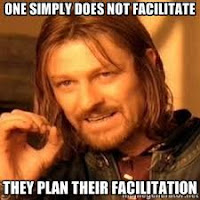 This week, I facilitated an executive team that I had not worked with before. I had one business day and a weekend to prepare.
This week, I facilitated an executive team that I had not worked with before. I had one business day and a weekend to prepare. It was a 2016 kick-off meeting to confirm commitment to the organization's mandate and strategic direction.
After a good briefing and homework, I was ready to go.
The facilitator's role is to ensure outcomes are met. Here are the guidelines I followed to encourage participation, surface issues and test for agreement:
- Develop a deep understanding of the meeting objectives – from multiple sources to remove personal biases
- Learn and use the language used by the team – not knowing their terms of reference creates a disconnect in discussions when time is spent having to educating you
- Ask about group dynamics and the roles (optimist, collaborator, contrarian, etc.) that each participant has played at past meetings – you can draw on these people when a specific role is needed in the conversation
- Research attendees on LinkedIn and company and industry news to get a sense of their past influences – also, note things you have in common with them to build immediate rapport
- Identify the participants who will be attending in person and on phone or video conference lines – remote attendees should speak first to ensure they are not forgotten
- After a brief introduction, ask people a question about their views – it refocuses them away from thoughts about other parts of their lives (the call they just had, an approaching deadline, etc.) and establishes a rhythm that you can maintain throughout the meeting
- Take notes on comments and agreements – verbatim comments are essential to the post meeting debrief
- Ensure everyone is included in the conversation – full participation leads to more balanced outcomes and perceived value of the meeting
- Provide perspective on comments based on your experience – use examples and metaphors that will resonate with attendees
- If discussions get heated, thank people for their honesty and candour – opposing views can lead to better decisions and demonstrate engagement of participants
- Leave enough time for final comments and review – 15 minutes is ideal for a two hour meeting
- Summarize agreements and next steps – include these in your notes, especially deadlines and those accountable for doing the work
- Clarify when the team will meet next – the date needs to align with timing of next steps
- Thank people for their participation – their investment of time and focus created the outcomes
- Follow up with notes using the team's PowerPoint template – it provides immediate team recognition and makes them easy to review at the team's next meeting
- Lead a 30 minute debrief with the team leader and other member(s) who asked you to facilitate – share overall perceptions including areas of alignment, opposition and overall group dynamics
You can add a lot of value as a meeting facilitator by focusing discussions, encouraging participation and ensuring outcomes are met. Following a set of guidelines will ensure you can do so at a moment's notice.
Phil


No comments:
Post a Comment